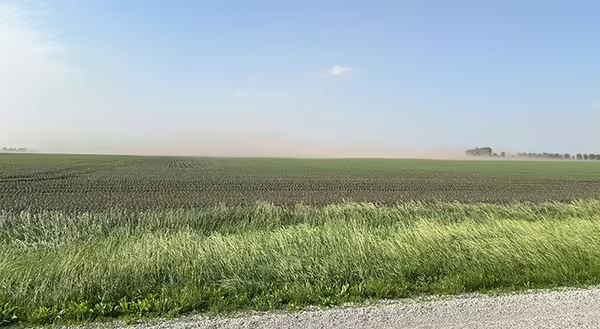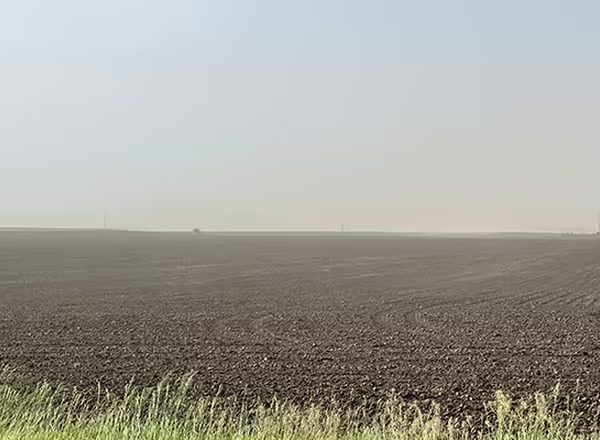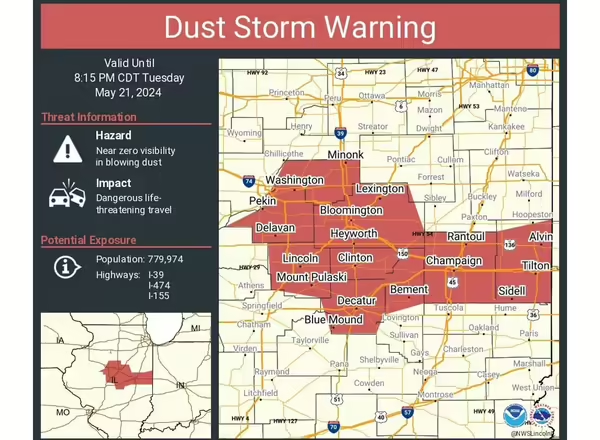
Many parts of Central Illinois, including Logan County, experienced high winds on May 21st, which caused large amounts of dust to be kicked up. These high winds and dust storms prompted the National Weather Service (NWS) to issue a Dust Storm Warning. This Warning stretched from Pekin to Decatur, to Lexington, and all the way to the border with Indiana. The Portions of Interstates 55 and 74 in McLean County were closed due to low visibility.
This is not the first time we have seen these conditions recently. High winds on May 1st, 2023, caused a similar dust storm that affected Interstate 55. The near-zero visibility caused by this dust storm caused a major accident that killed eight and injured dozens more. While dust storms are not common in Illinois, they have occurred before. Other than these recent storms, the NWS notes that other significant dust storms in Central Illinois occurred in May 1983, June 1990, and May 2017. When these storms occur, many in the public look at agriculture and the tillage practices producers use when preparing their fields for planting. While producers cannot control high winds, producers can employ practices to keep the soil in the field and reduce the risk of major dust storms occurring. This two-part blog series will analyze the causes and effects of dust storms and practices that producers can implement on their operations to reduce the likelihood of dust storms.
Wind erosion is an issue for not just producers in Illinois, but also across the United States and the world. Zobeck and Van Pelt noted that this type of erosion occurs on loose, dry, and bare soils when sediment is detached, transported, and deposited by strong winds. Scientists have studied the direct and indirect effects of soil erosion for hundreds of years. Looking at the onsite impacts of wind erosion, we can see that the loss of soil particles from crop fields can impact seeding stands in recently planted fields. This causes a producer to consider replanting and can lead to yield reductions. Wind erosion also causes dust storms, like the ones discussed at the beginning of this blog, that can cause severe damage and result in injury or death. Wind erosion can also have many offsite impacts on human health, the environment, and industry. High winds can carry small-diameter soil particles very long distances, which can also transport pathogenic microbes that harm humans and other animals. Wind erosion is not as simple as wind carrying soil particles through the air, as there are many different factors that play into the severity of wind erosion. Factors such as wind speed and direction, soil texture and moisture, and surface crusting all play a role in wind erosion. For example, coarser soils (i.e., sandier soils) tend to be more susceptible to wind erosion than finer-textured soils (i.e., clay loams) because the individual soil particles for sandier soils are larger in diameter than clay loams.
Wind erosion is a severe concern for producers across the United States and Central Illinois. High winds can carry soil particles away from the field, decreasing available topsoil and overall soil productivity. Additionally, soil particles carried by high winds can cause severe dust storms that impact local communities. Part two of this blog series will examine different practices producers can implement to reduce the likelihood of wind erosion and dust storms.
Part two of this blog series will analyze practices that farmers and producers can implement on their operations to reduce the impacts of wind erosion.

